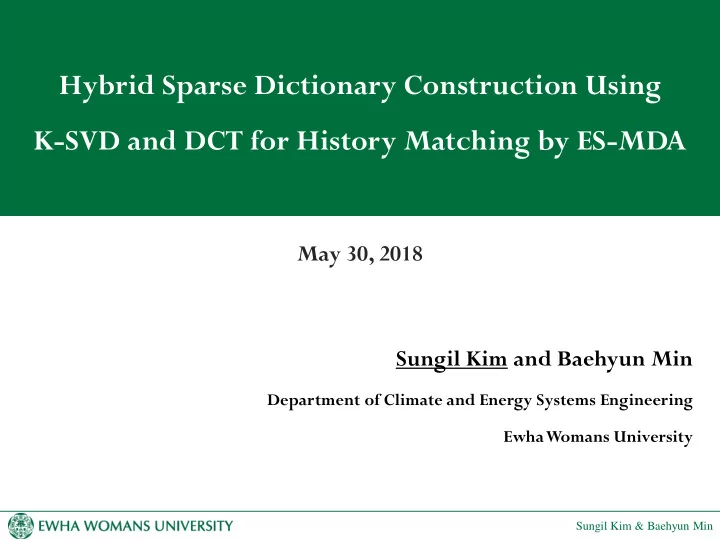

Hybrid Sparse Dictionary Construction Using K-SVD and DCT for History Matching by ES-MDA May 30, 2018 Sungil Kim and Baehyun Min Department of Climate and Energy Systems Engineering EwhaWomans University Sungil Kim & Baehyun Min
Contents 1.Introduction 2.Literature review 3.Methodology 4.Results & Discussion 5.Conclusions 2/19 Sungil Kim & Baehyun Min
Introduction (inverse modeling) or 𝐠 𝐧 = 𝐞 𝐞 = 𝐠 𝐧 Limited information 𝐧 : reservoir parameters with measurement error and expensive cost 𝐞 : simulation responses Reliable inverse modeling 𝐠 : a reservoir simulator Production rate Production rate History Unknown History Reliable Updated Model Time Time Past Future Past Future WOPR, WGPR, P ? ? ? P WBHP ? ? ? ? ? ? ? ? ? ? ? ? ? ? ? Given 𝐞 𝐩𝐜𝐭 P ? ? ? P Find 𝐧 3/19 Sungil Kim & Baehyun Min
Introduction (ensemble-based methods) ⚫ Objective function 𝐊 𝐧 = 𝐧 − 𝐧 𝐜 𝐔 𝐂 −𝟐 𝐧 − 𝐧 𝐜 + 𝐞 𝐩𝐜𝐭 − 𝐞 𝐔 𝐒 −𝟐 𝐞 𝐩𝐜𝐭 − 𝐞 𝛂𝐊 𝐧 = 𝟏 J b , Background term J o , Observation term 𝐧 = 𝐧 𝐜 + 𝐋(𝐞 𝐯𝐨𝐝 − 𝐞(𝐧 𝐜 )) 𝐋 = 𝐃 𝐧𝐞 (𝐃 𝐞𝐞 + 𝛃𝐃 𝐄 ) −𝟐 *Assuming Gaussian dist. (Emerick and Reynolds, 2013; Chen and Oliver, 2013) 𝐧 : state vector (model realization) Transformation of parameters of a channel reservoir 𝐧 𝐜 : state vector before update ◆ Distribution modification 𝐂 : covariance matrix of 𝐧 𝐜 • Normal Score Transformation (Shin et al. 2010) • Level Set (Lorentzen et al., 2013) 𝐞 : simulated response of a state vector ◆ Image process 𝐞 𝐩𝐜𝐭 : observation data • Discrete Cosine Transform (DCT) 𝐞 𝐯𝐨𝐝 : perturbed observed data (Jafarpour and McLaughlin, 2007) ◆ Learning algorithm 𝐒 : covariance matrix of observation error • K-Singular Value Decomposition (K-SVD) 𝛃 : inflating coefficient of 𝐃 𝐄 (Kreutz-Delgado et al., 2003; Aharon et al., 2006) 4/19 Sungil Kim & Baehyun Min
DCT and IDCT application 5/19 Sungil Kim & Baehyun Min
K-SVD for a geological dictionary Words selection A sentence “I love cookies” Or the book ‘Romeo & Juliet’ Or even every books of library 6/19 Sungil Kim & Baehyun Min
Procedures of K-SVD 7/19 Sungil Kim & Baehyun Min
Literature review ▪ Aharon et al. (2006): showed the efficacy of K-SVD in image reconstruction. ▪ Li and Jafarpour (2010): extracted essences of geologic features in DCT domain. ▪ Liu and Jafarpour (2013): investigated coupling effects of DCT and K-SVD for representations of facies connectivity and flow model calibration. ▪ Sana et al. (2016): built geologic dictionaries from thousands of static reservoir models using K-SVD and updated models by EnKF ▪ Proposed method: geologic dictionary update based on DCT and K-SVD in each assimilation of ES-MDA 8/19 Sungil Kim & Baehyun Min
Methodology (Update of a dictionary in ES-MDA) Methodology (Update of a dictionary in ES-MDA) 9/19 Sungil Kim & Baehyun Min
Methodology (Overall procedure) Update dictionary 10/19 Sungil Kim & Baehyun Min
Experimental setting 11/19 Sungil Kim & Baehyun Min
Dictionaries in each assimilation by the proposed method 12/19 Sungil Kim & Baehyun Min
Updated ensemble samples from five methods 13/19 Sungil Kim & Baehyun Min
Gas rate of the updated ensemble 14/19 Sungil Kim & Baehyun Min
Water rate of the updated ensemble 15/19 Sungil Kim & Baehyun Min
Computation time and error of five methods Only for construction of dictionaries Only for 8 wells on sand Initial ensemble 100% error 16/19 Sungil Kim & Baehyun Min
Conclusions 1. This study proposed a framework of ES-MDA coupled with DCT and K-SVD. 2. This study updated geologic dictionaries with qualified reservoir models considering dynamic observed data during each assimilation of ES-MDA. 3. The proposed method remarkably reduced computational cost and complexity. 4. ES-MDA+DCT+i-K-SVD worked properly and gave overall enhanced performance in terms of channel properties and prediction of productions. 17/19 Sungil Kim & Baehyun Min
References • Aharon, M., Elad, M., Bruckstein, A., 2006. K-SVD: An algorithm for designing overcomplete dictionaries for sparse representation. IEEE. T. Signal Proces. 54 (11), 4311 – 4322. • Chen,Y., Oliver, D.S., 2013. Levenberg-Marquardt forms of the iterative ensemble smoother for efficient history matching and uncertainty quantification. 17 (4), 689 – 703 • Emerick, A.A., Reynolds, A.C., 2013. Ensemble smoother with multiple data assimilation. Comput Geosci. 55 (2013), 3 – 15. • Kim, S. , Min, B., Lee, K., Jeong, H., 2018. Integration of an iterative update of sparse geologic dictionaries with ES-MDA for history matching of channelized reservoirs. Geofluids (May 2018, Accepted) • Li, L., Jafarpour, B., 2010. Effective solution of nonlinear subsurface flow inverse problems in sparse bases. Inverse Probl. 26 (10), 1 – 24. • Liu, E., Jafarpour, B., 2013. Learning sparse geologic dictionaries from low-rank representations of facies connectivity for flow model calibration. Water Resour. Res. 49 (10), 7088 – 7101. • Sana, F., Katterbauer, K., Al-Naffouri, T.Y., Hoteit, I., 2016. Orthogonal matching pursuit for enhanced recovery of sparse geological structures with the ensemble Kalman filter. IEEE. J. Sel. Top Appl. 9 (4), 1710 – 1724. • Shin, Y., Jeong, H., Choe, J., 2010. Reservoir characterization using an EnKF and a non-parametric approach for highly non-Gaussian permeability fields. Energ. Source Part A. 32 (16), 1569 – 1578. 18/19 Sungil Kim & Baehyun Min
Q & A Thank you for your attention Sungil Kim kim@cerfacs.fr kimsnu@ewha.ac.kr Acknowledgements We are thankful for support by KOGAS 19/19 Sungil Kim & Baehyun Min
Recommend
More recommend